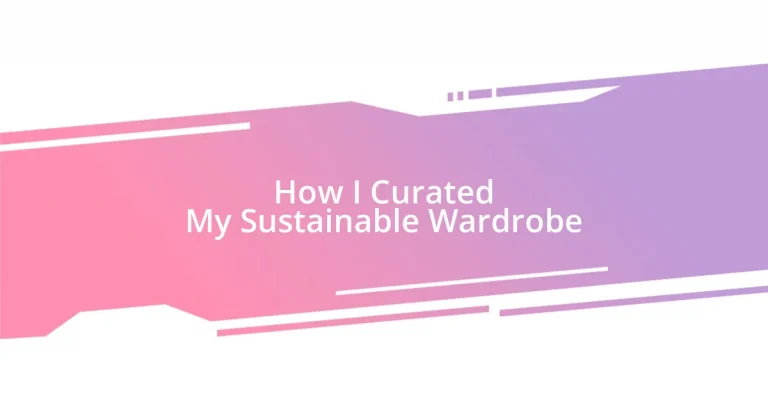Key takeaways:
- Sustainable fashion is a philosophy that emphasizes eco-friendly materials, ethical labor practices, and prioritizing quality over quantity in clothing choices.
- Creating a sustainable wardrobe involves evaluating current clothing, engaging in secondhand shopping, and seeking brands that align with ethical and environmental values.
- Caring for clothes through maintenance and organization, along with the concept of a capsule wardrobe, enhances personal connection and mindful consumption in fashion.
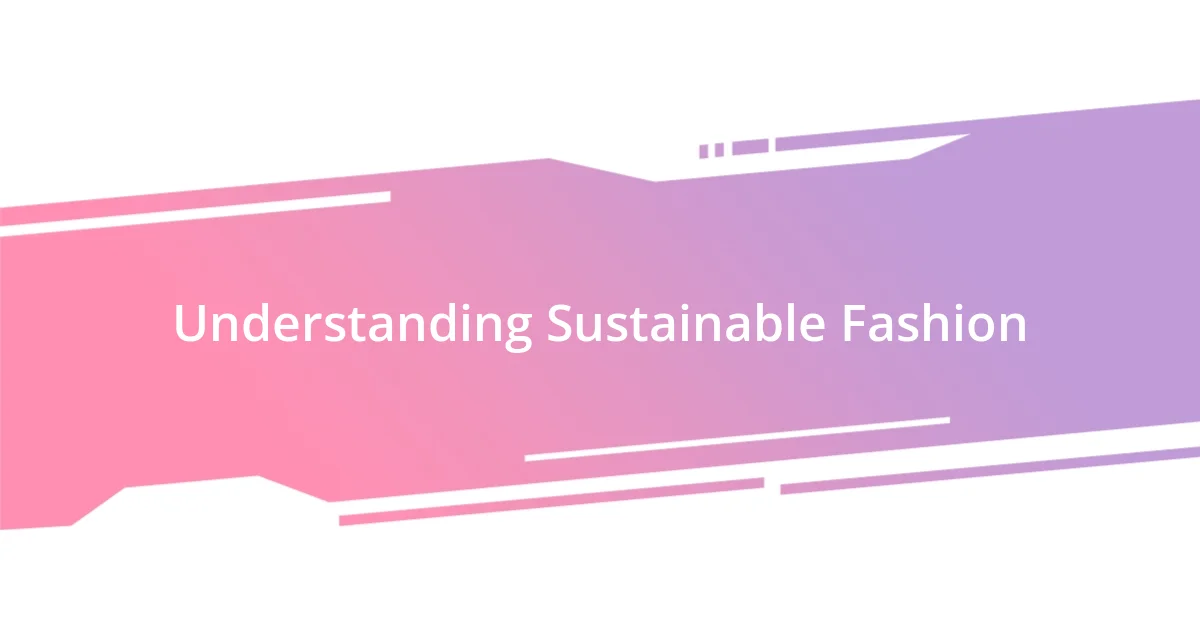
Understanding Sustainable Fashion
Sustainable fashion is more than just a trend; it’s a philosophy rooted in making mindful choices about how we consume clothes. I remember the first time I really understood this concept—it hit me when I learned that the fashion industry is one of the largest polluters in the world. Seeing that statistic made me question my own shopping habits: how can I justify buying a new dress when so much damage is being done to our planet?
When I started to explore sustainable fashion, I realized it encompasses not only eco-friendly materials but also ethical labor practices. I still recall visiting a local boutique that sourced its pieces from fair-trade artisans. It felt incredibly rewarding to know that my purchase helped support someone’s livelihood. It made me think: what if each clothing choice we make could reflect our values and support a better world?
Moreover, understanding sustainable fashion has taught me the importance of quality over quantity. I’ve had those moments of instant gratification after buying a cheap item, only to wear it a couple of times before it falls apart. Instead, I now cherish each curated piece in my wardrobe, knowing that they’re not just clothes but stories of sustainability and care for our environment. Isn’t it fascinating to realize that what we wear can carry a greater purpose?

Assessing Your Current Wardrobe
When I decided to curate my sustainable wardrobe, the first step was to take a hard look at what I already owned. Opening my closet felt like cracking a time capsule; I unearthed pieces from various phases of my life, some of which I hadn’t worn in years. It was a little nostalgic but also eye-opening as I recognized how many clothes no longer aligned with my values or sense of personal style.
To effectively assess your current wardrobe, consider these points:
- Identify your go-to pieces: What do you wear regularly? This will help highlight what you truly value.
- Evaluate the quality: Are the fabrics durable? Is the stitching holding up? Quality matters in sustainability.
- Reflect on emotional attachment: Which items hold special memories or sentiments? It’s okay to hold onto pieces that resonate with you.
- Check for versatility: Do your clothes mix and match? Pieces that can serve multiple occasions often reduce the need for excessive purchases.
- Consider your lifestyle: Are your clothes practical for your everyday activities? It’s crucial to have a wardrobe that reflects your daily reality.
Digging deeper into my closet, I found shirts I had bought on impulse—once trendy and now just gathering dust. It dawned on me that every item in my wardrobe should serve a purpose, whether it’s a cherished memory or a sustainable ethical choice. This realization solidified my commitment to a wardrobe that truly represents who I am and what I stand for.
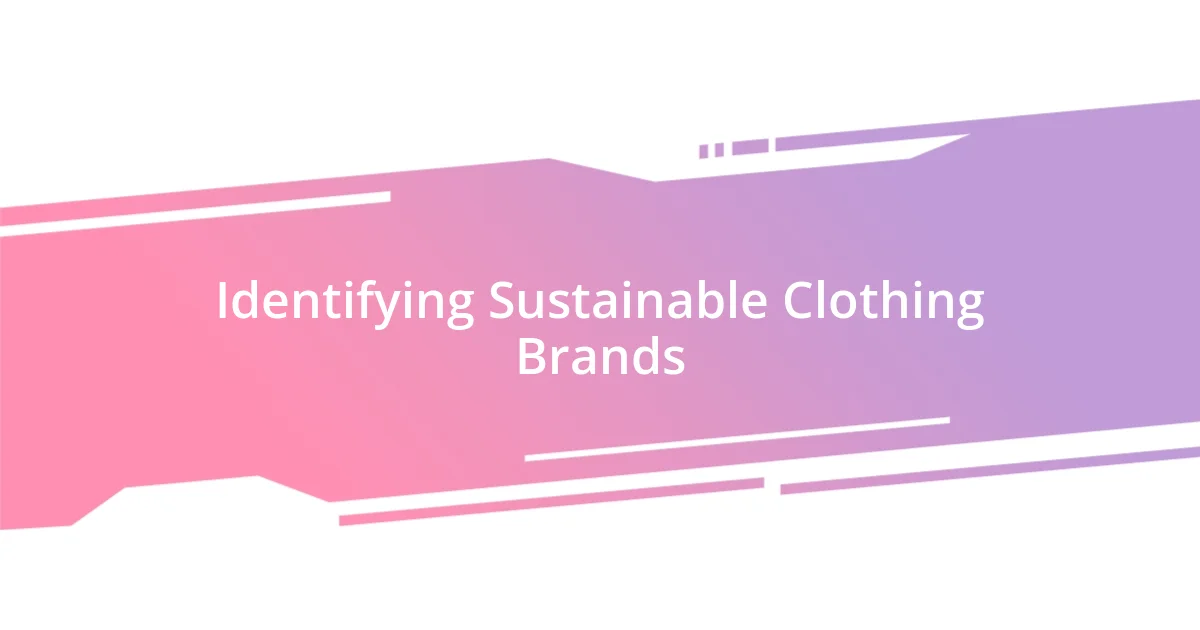
Identifying Sustainable Clothing Brands
Identifying sustainable clothing brands can feel like navigating a maze, but it’s a rewarding journey. One of the first steps I took was researching brands that prioritize eco-friendly materials, ethical labor practices, and transparent supply chains. I vividly remember the thrill of discovering a small outdoor brand that uses recycled materials for their jackets, knowing that my purchase would reduce waste and support environmentally conscious practices. This kind of information empowers consumers, making us feel more connected to the clothing we choose to wear.
As I delved deeper into my search for sustainable brands, I found that certifications can also serve as a helpful guide. Organizations like GOTS (Global Organic Textile Standard) and Fair Trade ensure that the products meet specific criteria for sustainability and ethical production. One afternoon, while sipping a cup of tea, I scrolled through a brand’s website that proudly displayed its certifications. This transparency made a significant impact on me—after all, knowing that my clothing aligns with my values brings a sense of peace and fulfillment.
Another aspect I considered was the brand’s storytelling. I often look for companies that share their journey, from sourcing materials to the artisans behind the garments. One evening, I came across a video of artisans weaving textiles in a small village; it made the fabric in my hands feel more alive and meaningful. It reminded me that every piece of clothing has a story, and my choices can support individuals and communities. By looking for these personal connections, I make informed decisions that resonate with my values.
| Brand | Key Features |
|---|---|
| Patagonia | Eco-friendly materials, Fair Trade certified, transparent supply chain |
| Eileen Fisher | Commitment to sustainable practices, high-quality timeless pieces, social responsibility |
| Reformation | Trendy styles made from sustainable materials, carbon-neutral practices, and detailed transparency reports |

Choosing Quality Over Quantity
Choosing quality over quantity has fundamentally changed how I approach my wardrobe. I remember the thrill of buying clothes in bulk, overwhelmed by sales and discounts, but this often led to regret and a wardrobe full of items I rarely wore. Now, I focus on investing in well-made pieces that not only fit my style but will last through the seasons. After all, when was the last time a fleeting trend provided me with the joy that a timeless staple brings?
A turning point for me was when I splurged on a beautiful wool coat. Initially, I hesitated because it seemed like a hefty investment. However, the moment I slipped it on, I understood its worth. The warmth enveloped me like a hug, and its classic design meant I would wear it year after year, rather than tossing it aside after one season. It’s a reminder that quality pieces can be both a practical choice and a source of joy.
Additionally, I began to evaluate the stories behind the clothes I chose. I recall purchasing a dress made from organic cotton, not just because it felt soft against my skin, but because it was crafted by artisans who share the same values I do. Each garment I select now feels significant, a reflection of my commitment to sustainability, and ultimately, it fosters a deeper appreciation for truly quality pieces. Isn’t it empowering to know that our fashion choices can express our values and support ethical practices?

Incorporating Secondhand Shopping
Incorporating secondhand shopping into my wardrobe has been a transformative experience. I vividly remember the first time I stepped into a thrift store; the overwhelming mix of textures and colors felt like stepping into a treasure trove. I found a vintage leather jacket that fit perfectly and smelled faintly of the past. Not only did I save money, but I also gifted a new life to that jacket, which was a satisfying way to support sustainability.
As I continued my secondhand journey, I often tackled the challenge of searching for unique pieces rather than the latest trends. While exploring a local flea market one Saturday, I stumbled upon a charming dress adorned with intricate embroidery. It reminded me of something my grandmother might have worn. The excitement of discovering something truly special, paired with the nostalgia it evoked, made it clear to me that secondhand shops are more about the stories behind each item than just their price tags.
I’ve also made it a habit to organize clothing swaps with my friends. One afternoon, as we exchanged pieces over a homemade brunch, it turned into a fun dance of nostalgia and creativity. It was heartwarming to see my friend excitedly trying on the oversized sweater I once loved. This communal approach not only reduces waste but fosters a deeper connection with the clothes we wear—how powerful is it to know that a piece of clothing can hold stories from multiple lives before landing in mine?
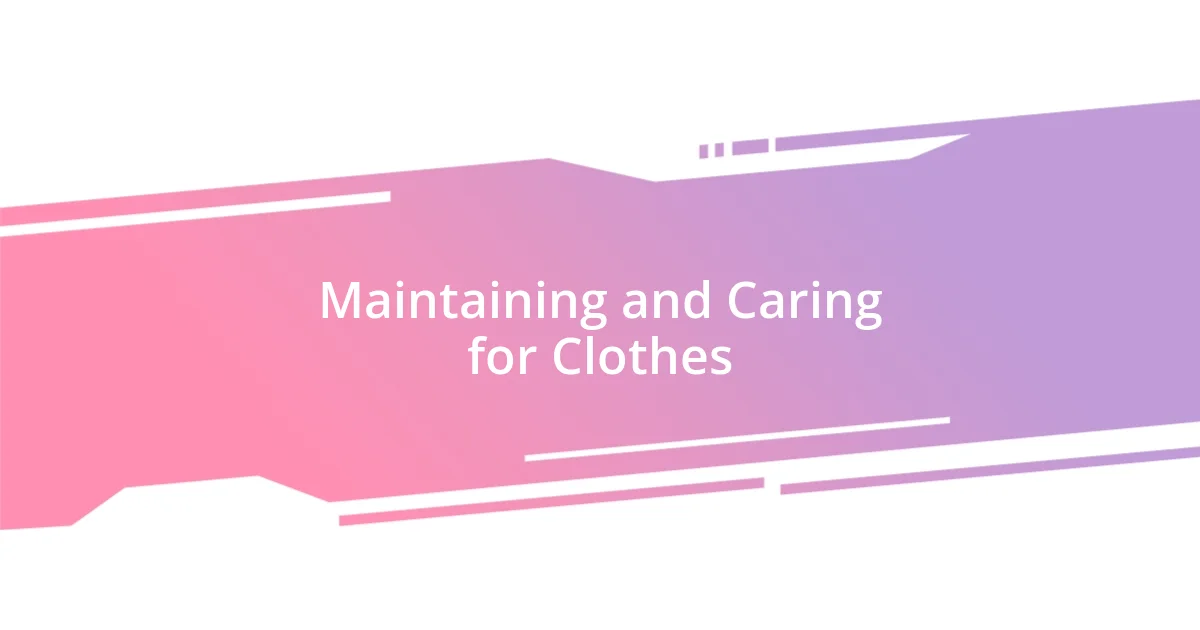
Maintaining and Caring for Clothes
Caring for my clothes has become a daily ritual that nurtures both my wardrobe and the planet. I remember the first time I learned about hand-washing delicate fabrics; it felt tedious at first, but I quickly realized how satisfying it was to extend the life of my favorite garments. Now, I often think about how each gentle wash or proper ironing is an act of love, allowing me to cherish these pieces even longer. When was the last time you took a moment to appreciate the process of caring for your clothes?
Another important aspect of maintenance is proper storage. I’ve invested in cotton garment bags for seasonal shifts so that my woolens and silks remain protected during the off-months. I used to stuff everything into a closet without a second thought, and of course, I encountered a few moth-eaten surprises over time. Now, that sense of preservation makes me feel like a guardian of my eco-friendly wardrobe. Maintaining organization not only keeps my clothes in the best shape but also makes getting dressed each day a more enjoyable experience.
I’ve also learned the art of mending and upcycling, which brings me immense satisfaction. A couple of months ago, I turned a pair of jeans with a small tear into trendy cut-offs instead of tossing them out. Each little repair or creative tweak feels empowering, allowing me to express my individuality while contributing to sustainability. Have you ever tried mending something you thought was beyond saving? It’s a gratifying process that can add a personal touch to your wardrobe while reducing waste.
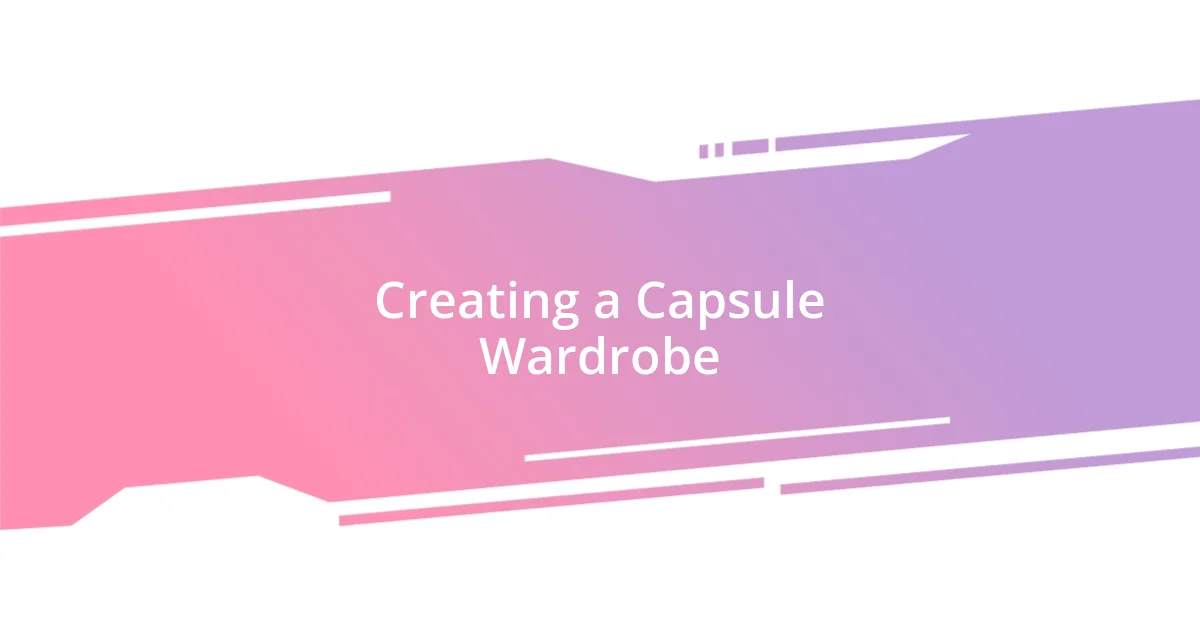
Creating a Capsule Wardrobe
Creating a capsule wardrobe was a game changer for me and my approach to style. Initially, I was overwhelmed at the idea of paring down my closet, but with a little guidance, I found it incredibly liberating. I remember gathering my clothes and laying them all out; it was a revealing moment. I had so many pieces that I rarely wore, and it felt like I was releasing the weight of indecision. Is there a more freeing feeling than knowing exactly what you own and loving every piece?
I focused on selecting versatile items that could be mixed and matched effortlessly. It was like playing dress-up with a curated collection—each piece felt like a solid building block for my outfits. I decided on classic colors and timeless styles, which allowed for endless combinations that reflected my personality. One day, I paired a simple white tee with a vibrant patterned skirt, and it brought an inexplicable joy to my day. Have you tried experimenting with your favorite pieces? You might be surprised at how imaginative you can get!
What I also learned was the importance of quality over quantity. Investing in a few high-quality staples, like a well-fitted pair of black jeans or a tailored blazer, has made a huge difference in how I feel about my wardrobe. There was a time when I would shop on impulse for trendy items that didn’t last, but now my mindset has shifted. Each piece is a deliberate choice, and I find myself feeling proud to wear them, knowing they were selected with intention. Have you ever considered the impact of quality pieces on not just your wardrobe, but your confidence? It’s a shift worth experiencing.












